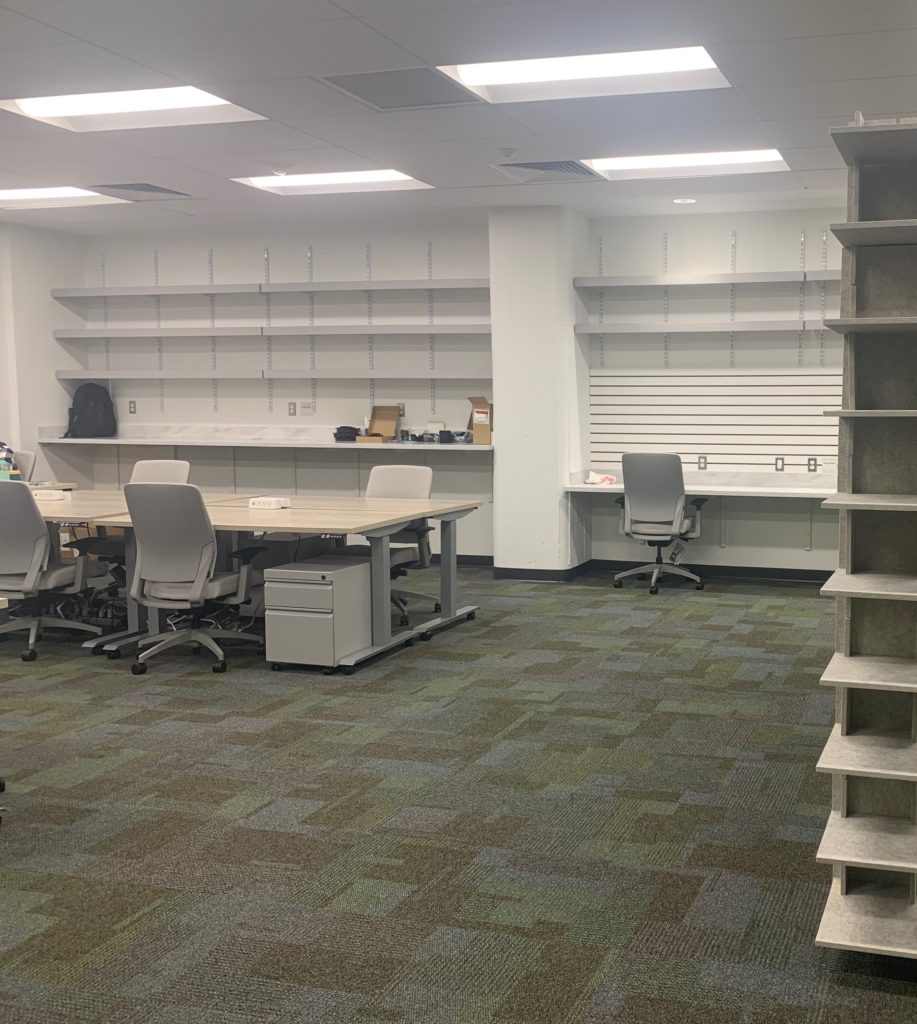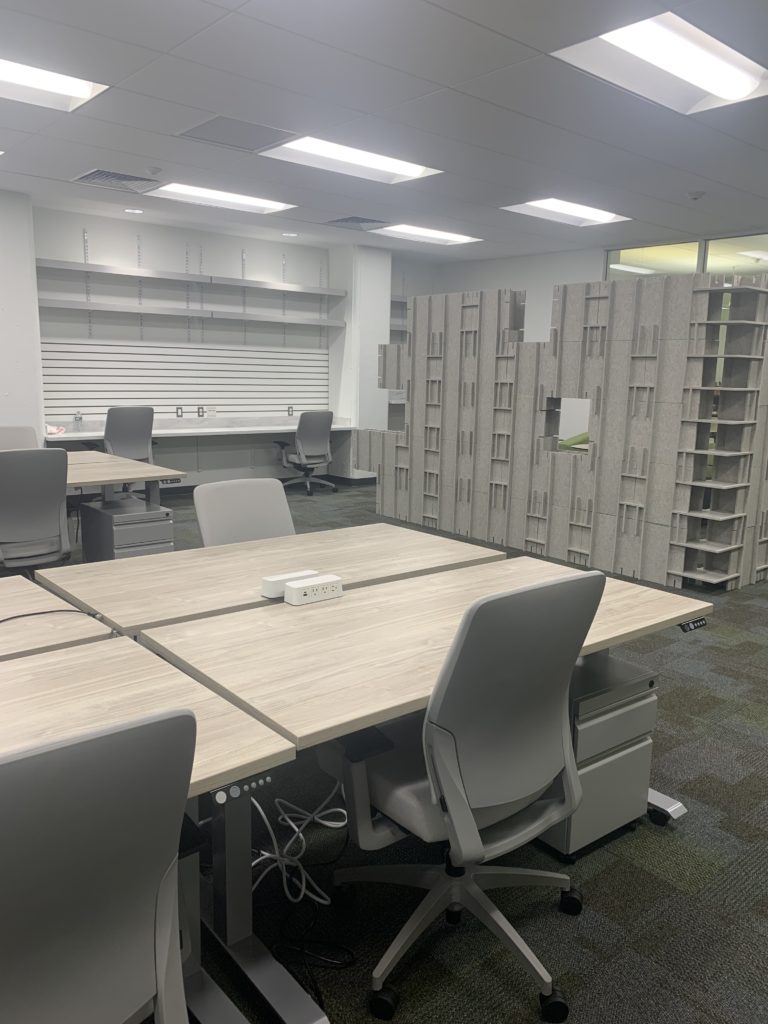As the School of Engineering and Applied Science grows, so do the rooms that house all of the creative minds within our departments. Just in time for the Fall 2022 semester, two labs that are a part of the C.I.S. Department and are located in the Moore Building have gotten a makeover this past summer and the faculty and students are thrilled. The Distributed Systems Laboratory (DSL) in Moore 100 and The SIG Center for Computer Graphics in Moore 103 have both undergone renovations for more student space to collaborate, create and liven up the space!
Cheryl Hickey, the Administrative/Event Coordinator in C.I.S., collaborated with the directors of the labs and a design team. She was tasked with choosing the furniture, color scheme, and layout that would best suit the space and the students. The Distributed Systems Lab received all new desks as well as a redone kitchen area for faculty and students. Jonathan M. Smith, Olga and Alberico Pompa Professor of C.I.S. said, “The DSL renovation allow for maximum flexibility in placement of student desks and experiments. Moving the network drops into the DSL machine room freed up space in the main areas for scholarly interaction and increased physical security.” The lab now encourages students to work together within the space better than ever before.


“The DSL renovation is nicely done and timely. I know many of our students really appreciate the new space. The new desks are superb. These days, when I walk past DSL, I’m pleased to see many students interacting with each other. The vibrancy and bustle are back in DSL! Our DSL seminars have also been packed with faculty and students listening to each other’s research. Nothing beats in-person interactions, and the best ideas happen when students talk and iterate through ideas in close proximity.” (Boon Thau Loo, Director of DSL)
Students have noticed the changes to the DSL lab as well since they began the semester just over a month ago. Jess Woods, a C.I.S. PhD being advised by Sebastian Angel, stated that, “It’s nice having our own functional cabinets/lockers. There are more desks and less clutter, which seems to encourage more people to come to campus to work, which makes the environment more collaborative and productive”. Having a space post-Covid that is inviting and open for all students to take advantage of is incredibly positive for the department.
While a part of the SIG Center for Computer Graphics is fully renovated as of this past summer, the lab is still continuing to grow. New technologies are in the works in addition to a couple of new faculty members who will be officially joining the department this coming Spring 2023 semester. Incoming assistant professor in Computer Graphics, Lingjie Liu, stated that there will be many upgrades to the space and equipment including GPU clusters and data storage space in support of research development.
Upon her arrival to Penn Engineering, Lingjie will “we will also purchase and set up a multi-view volumetric camera capture stage for capturing human motions and human-object interactions with multiple synchronized cameras (about 40 cameras).” This set of equipment will be an addition to the labs’ Vicon 16-camera motion capture system.
“The research focus of the new SIG Lab will be developing Artificial Intelligence (AI) technologies for perceiving, understanding, and interacting with 3D objects, people, and environments. Specifically, we will pursue three research goals: (1) High-quality reconstruction of real-world scenes from sparse RGB (camera) images; (2) Photo-realistic image synthesis of real-world scenes with 3D control; and (3) Large-scale 3D scene generation for 3D machine learning tasks.
Lingjie states that the SIG Lab’s new research focus will be “developing Artificial Intelligence (AI) technologies for perceiving, understanding, and interacting with 3D objects, people, and environments.” There are three research goals that the lab will pursue which include:
- High-quality reconstruction of real-world scenes from sparse RGB (camera) images
- Photo-realistic image synthesis of real-world scenes with 3D control
- Large-scale 3D scene generation for 3D machine learning tasks.
“We will approach these goals by designing new algorithms that incorporate AI advances into classical computer graphics methods. We believe that with the new research focus and the facilities upgrade, we will create new research achievements and continue the success of our SIG Lab.”


The finished and fully furnished side of the SIG lab will now be filled with another incoming assistant professor of C.I.S. and ESE, Mingmin Zhao‘s students. “Working with the renovation and designer team was a pleasure, and the new lab is absolutely gorgeous. I am excited to attract and recruit more students and spend time with them in the new lab.”
While touring SIG lab earlier this month, there were several students hard at work and raved about how much they enjoy spending time in the space. One PhD student who is being advised by Mingmin, Gaoxiang Luo, said, “The renovation of Moore 103B is way beyond my expectation. The workspace shelves allow us to store electronic components, while the wall pegboard allows us to hang tools. While the space is large enough for us to conduct wireless experiments using radar with a certain distance, the ESD flooring further ensures our safety. It’s also worth mentioning that I love the ergonomic height-adjustable desk and chair, which is particularly useful for our health as we work with our computer frequently nowadays.”
It is incredible to see the impact that this renovation has had on the students and faculty. The department is looking forward to seeing the work and successes that come out of these two labs for this new generation of students in Penn Engineering!